Modern French Sculpture - part 2
 Paris Exposition, 1900
Paris Exposition, 1900Here is more text taken from Lorado Taft's "Modern Tendencies In Sculpture". In the last episode, he castigated the avant garde( Matisse, Brancusi, Gaudier-Brzeska) -- and now he applies his whip to the decadent academy. (my comments -- as I think of them -- will be appearing in yellow)
Readers are invited to post their responses to all of these comments and statues -- and if they seem to enhance this entry, I'll edit them into the text -- in green or various other colors.
Thus in place of a self-respecting art worthy of its ancient lineage, the Paris of yesterday-that is, the Paris of immediately before the war--offered her visitors the puerile effronteries of these harlequins, delighting through their very ineptitude a public avid of new sensations. Unbridled realism and cleverness had run their course, and the jaded critics found refreshment in pretense of naiveté and in willful bungling .
One protests that these things are merely the froth of the annual exhibitions, that there is always a great body of good work, less obtrusive because decent. The serious masters toiled on unmoved, and the epidemic would speedily have run its course. This is doubtless true, but the fact remains that there has been for some time a weakness in French sculpture far more real and more deplorable than any sporadic attack of "cubism" or “vorticism." This is the unmonumental character of French monuments. If I permit myself to criticize, it is because my love for the nation and for its art is well known. An inconsistency in a friend is so trying; a blemish in a splendid character is so conspicuous! However great one's admiration for modern French sculpture, it must be confessed ,that recent French memorials-Parisian' and provincial alike-- are as a rule tawdry and in poor taste. Qne can count on his fingers the distinguished works erected in Paris since 1900; the ignoble "stunts" given eternalizaton there within the last few years are too many to catalogue. A magazine of the capital recently inaugurated a symposium on "The Ugliest Monument in Paris." The returns were abundant and enthusiastic. At least thirty prominent writers responded, and the frank avowal of their feelings was reassuring to one who had feared that they really liked these things. Unquestionably the best sculptors of our time, these masters of form have produced a monumental art more formless than can be found anywhere else excepting in Italy. Professor Mather has well said: "To regain the lost capacity for monumental design is the problem of modern art in whatever branch." Nowhere does one so realize the truth of this utterance as when passing in review the recent memorials of France.
We should not hold Rodin personally responsible for the present decadence any more than we can charge the decline of the Italian Renaissance to Michelangelo. We must recognize, .however, that the exalted position. Of the master made his Influence all-powerful. His peculiarities and weaknesses were more easily copied than his real. inherent strength, the growth of a lifetime. So the lesser men followed, developing with enthusiasm any license encouraged by such high example.
Rodin's carelessness of the silhouette was gratefully emulated by an army of young sculptors and by not a few of the older men as well. Dalou's tribute to Delacroix (Fig. 63) in the Luxembourg Gardens is an unhappy tribute to Rodin also in that it is one of the most offensive and pernicious examples of his methods.
I assume that by "careless of the silhouette" Taft refers to the space surrounding the statue -- since I think it's clear that Rodin draws his contours very carefully -- while the surrounding space is left feeling confused - which is another way of saying that he has no interest in architecture -- his pieces are intended to grasp and hold attention to themselves
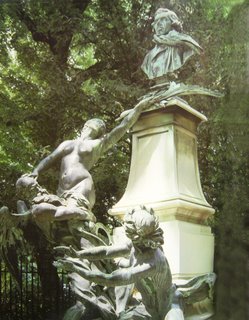
 Plate 63-66
Plate 63-66Its erection marks an important milestone in the decadence of French monumental art, for its influence has been immense. It was the sculptor-anarchist's protest against the established order; in it every principle of dignified memorial art was overturned and derided. The stolid bust of the painter is assailed by a fat figure of "Fame," a nude female of adventurous mien, who endeavors to climb his slender pedestal in order to decorate him. Her voluptuous form is precariously supported by a violent "Father Time" who, taxed to the utmost, is encouraged by Apollo with outstretched, applauding hands. The spiral composition is ingenious, but these tumultuous acrobatics are undignified and irritating. There is no sense of eternity where Time plays such pranks.
One of the things that's struck me about most of these monuments in Taft's lecture is that they honor poets-novelists-painters i.e. artists -- rather than saints, kings, or generals. So maybe the kind of dignity that Taft wants is not really appropriate for them -- and the better question might be: does Victor Hugo or Eugene Delacroix really deserve a public monument ? Isn't their own work monument enough ? Or if a monument must be built -- isn't Dalou's playful, Baroque nonsense appropriate ? I think it's a good statue -- although, completely void of orientalism, I think it would have been a better fit for Berlioz than Delacroix. And maybe Taft is being just a bit too stodgy-puritanical-Midwestern here - where the "nude female of adventurous mien" is more like a sexually promiscuous nymph, and less like the sorority girls that Taft wraps up in togas for his own public monuments.
After the "Delacroix" the present generation followed pell-mell. M. Puech, once so promising, showed steady decline from that early and beautiful work of his, "The Muse of Andre Chenier" (Fig. 67), in the Luxembpurg. His "Siren" (Fig. 69) was all wings and waves and ,fishtails, picturesquely incoherent.
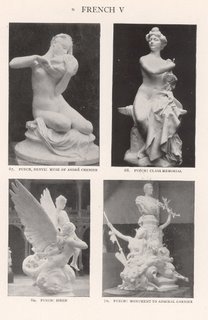 Plate 67-70
Plate 67-70I assume that Taft is writing about the actual statues and not the pictures that he's posted -- but regarding these pictures -- I find plate 67 to be a bit ennervated (i.e. boring) and plate 69 to be light-hearted and pleasing. I'm just thinking that perhaps light-hearted fantasy is what this sculptor does best -- although I'm not sure I'd want to see these things any larger than 20" high.
His famous relief, 'The Nymph of the Seine,'" a dainty and fragile nude of most personal look, was "too true to be good "~too faithful to the model to be very noble sculpture. Such things may perhaps be excusable in relief, protected as they are by the conventions of that delicate form of art, but they mark a dangerous tendency.
Even in the beauty of the relief, "The Vision of Saint Anthony," I find a threatening symptom. When clouds begin to appear in sculpture, then beware! Waves are sufficiently perilous, but the marble clouds which incrust the walls and columns of so many Jesuit churches of Europe are like the fungi which they resemble, the symbols of melancholy decay.
Well -- there you have it -- Taft doesn't like the Baroque period either. The light and airy (of the counter-reformation) just makes him depressed.
The recent public works of M. Puech are lamentable. A class memorial in a manual-training school (Fig. 68) shows a saucy Parisienne, quite nude, of course, seated upon an anvil and toying with a pair of pincers. The blithe young lady of the up-to-date coiffure is a perfect embodiment of assurance and inadequacy. Imagine intelligent toil personified in such guise!
I'm with Taft on this one -- the energy of the piece is broken -- and the theme should be taken more seriously (although -- come to think of it - I think I once saw a statistic about the high percentage of working girls in fin-de-siecle Paris who were employed, at least once, in a brothel)
This popular sculptor has done another thing quite as ludicrously unfortunate. His monument to a certain Admiral Garnier (Fig. 70), on the Avenue de l'Observatoire, shows a portrait bust of a hero of oriental seas rising from a surging tangle of Tritons and mermaids, waving arms, palm branches, and carved paddles. Confusion reigns. The very commonplace admiral with the Dundreary side-whiskers seems to find it impossible to conceal a look of polite inquiry in the face of this sculptural explosion.
Yes -- this piece is a hoot -- but maybe it was intentionally so. Wrapping up the good admiral's bust like a Roman senator -- that is laying it on pretty thick -- is it possible that there's a sense of humor here that's flown right over the head of our Midwest American sculptor ? The piece doesn't really look bad to me -- and if you can stop laughing -- it's rather elegant.
Another of M. Puech's fantastic performances of recent date is a monument-or shall I say a merry-go-round dedicated to Charles Perrault, a writer for children .(Fig 77).
 Figure 77
Figure 77M. Larche carved some time ago a delightful group, "Les Violettes," three little children, exquisitely tender and poetic. The same sculptor's monument to Corot (Fig .71), recently erected, is a trivial conception a bust of the great painter upon a formless pedestal, built apparently of clouds; then the inevitable nude woman, ostensibly paying homage to the bust but in reality playing hide and seek with the public. She is not one of Corot's vaporous idealizations, but evidently a portrait of the little minx who posed for the figure. One feels that the honest old paysagiste would have been embarrassed by the juxtaposition.
Maybe I'm a post-modernist after all -- but can't we allow sculpture to serve a variety of purpose - from the sublime to the ridiculous ? Yes, Corot's paintings are less jocular fantasies -- but he wasn't a saint after all. Honoring all these male artists by enveloping them with romping nymphettes -- there just seems to be a certain good sense to it -- connecting, as it does, sexual expression with creativity. There are, by the way, no monuments to Loredo Taft -- even in his beloved Chicago. But if I were to make one -- I'd also have feral young women dancing around his plinth. Who wants to look at yet another bust of a serious old man ?
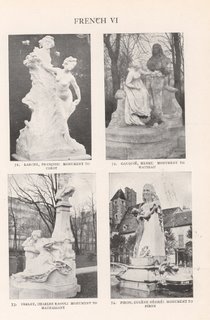 Plate 71-74
Plate 71-74Gauquie, in his memorial to Watteau (Fig. 72), has a better excuse for his playful treatment of the theme. The master of beribboned sheep and charmingly impossible shepherdesses could not be more fitly honored than by a monument of Sevres or Dresden ware. One would imagine this little lady right off from a mantelpiece.
 Gauquie memorial to Watteau
Gauquie memorial to WatteauI think one of my problems with Taft's critiques -- is that he hasn't seen just how stiff-awkward-turgid-broken monumental figure sculpture became in the late 20th Century. If he had -- he might have appreciated the sensual, gentle elegance of this work (and Sevres and Dresden ware as well)
In Verlet's "Maupassant" (Fig. 73) we have modern realism in all its glory. Every article of wearing apparel is satisfactorily accounted for. Maupassant would have been gratified.
There is something constipated about this piece -- with the feeling that it involved a checklist of details -- much like the ordinary cemetery work of that period
One of the funniest of the series so opportunely interrupted by the war is a monument of admirable workmanship erected in the city of Dijon:a few years ago in memory of the old-time poet Piron (fi,g. 74). This pious tribute of a descendant is too much even for the stone image, which joins sympathetically in the laugh. The climax is perhaps reached in a proposed memorial to Rabelais (Fig. 75), which at the opening of the war was about to be erected in Nimes. Should the project be forever thwarted the cataclysm of nations will have one good mark to its credit.
When a sculptor of Mercie's talent celebrates a brother artist as he did Baudry (Fig. 64);
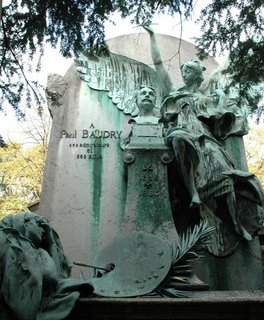 Mercie's monument to Baudry
Mercie's monument to BaudryThis one looks elegant -- approaching powerful-- to me -- and I'm glad Taft has introduced me to it. This is heads above any of the cemetery sculpture here in Chicago --including Taft's "Crusader" and "Eternal Silence" at Graceland
when an acknowledged master like Barrias closes his artistic career with such a paroxysm in metal as he created to the memory of Victor Hugo {Figs. 65 and 66);

when Fremiet undertakes to immortalize Raffet (Fig. 78) with a bronze joke of a grenadier chasing himself around a post,

These pieces are now beyond reproach, as sadly -- both of them were melted down to recover metal in German occupied Paris.
 The Fremiet in the junk wagon, 1941
The Fremiet in the junk wagon, 1941one must recognize that the weakness is inherent in the ideals of the time. Simplicity, serenity, dignity -all those qualities of a truly monumental art have disappeared to make way for violence and vociferation. That precious "hint of eternity" which is sculpture's greatest asset has been completely eliminated.
A fine list of qualities -- but what's missing here (and in Taft's own sculpture) is "power" -- and without power -- we have the effete and the banal.
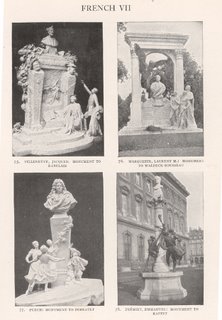 Plate 75-78
Plate 75-78Ingenious variations of the well-worn motif may be found in a number of recent public monuments in Paris and the provincial cities. The veteran Mathurin Moreau in 1907 received the medal of honor of the Salon for his "Pierre Joigneaux" (Fig. 82), now at Beaune. Imagine this sculptured valentine in the city which possesses Rude's superb "Monge"! It is, however, a dignified 'work compared to the monument to Carnot (fig. 79) of the same city. Pierre Roche has cleverly elected to have his attendant figures carry the bust of Dalou (Fig. 81) until a suitable pedaestal be provided. One wishes that the support were a little more assured; the nude figure is too evidently straining under its burden.
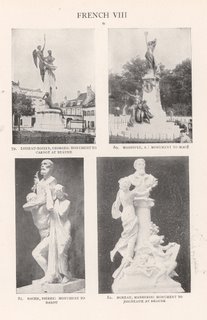 Plate 79-82
Plate 79-82An "intellectual" among the French sculptors is Gustave Michel, whose regal "La Pensee"
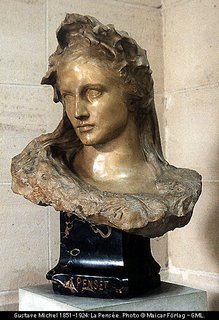 La Pensee
La Penseeand graceful "Le Reve" have long been favorites of the Luxembourg collection. His memorial to Jules Ferry (Fig. 85)
 Memorial to Jules Ferry
Memorial to Jules Ferryis a perfunctory and empty group which blockades a path in the Garden of the Tuileries to the outspoken irritation of the public. On the other hand Champeil's "Benjamin Godard" (Fig. 84) is not lacking in distinction.
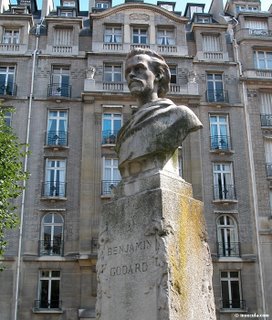 Memorial to Benjamin Godard
Memorial to Benjamin GodardMercie's '.'Gounod" (Fig. 87) is one of the most interesting and significant of these compositions, explaining itself at a glance. Its light touch has charm if not power. Saint-Marceaux’s "quality of unexpectedness" seldom failed him. His “Dumas Fils" (Fig. 88) is a great favorite,
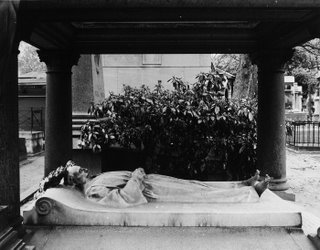 Dumas Fils
Dumas Filsbut is fragile compared with his "Daudet" (Fig. 90). This admirable creation is completely unacademic without being bizarre. It points the way to a monumental art on new and striking lines. Of the same type is Sicard's "George Sand" (Fig. 89) in the Luxembourg Garden, to be spoken of later. The Barbey memorial (Fig. 83) by the same sculptor has not been surpassed in recent years; of it likewise I shall have more to say.
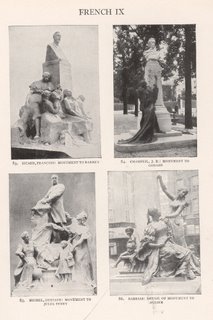 Figures 83-86
Figures 83-86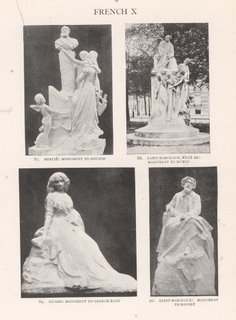 Figures 87-90
Figures 87-90I'm joining Taft in liking these more somber, serious pieces - as he introduces words like "power", "new and striking lines" for that which is "unacademic but not bizarre" -- and demotes that which is "fragile". But maybe they're too quiet to be noticed: I can't find any of them on the internet
Falguiere's valedictory, "Henri de la Rochejaquelin" (Fig. 91), is very fine. Its subtle blend of the gentleman of fashion and the fiery defender of the country is a triumphant expression not only of the great sculptor who gave it form but of a great people. One perceives today that this reminiscent work was grandly prophetic. Falguiere was not always so inspired. In fact the word inspiration seems a little out of place in connection with an artist whose theme was generally the flesh. Brownell has told us that he was at his best in subjects "frankly carnal." We all know his splendid travesty on the chaste Diana (Fig. 92)-that magnificent piece of modeling, with name so incongruous.
 Diana (bronze)
Diana (bronze)A large photograph of his "Woman with a Peacock" (Fig. 93) was, I remember, the chief decoration of MacMonnies' Parisian studio, treasured like a sacred ikon.’ It was a beautifully simplified study of a model, but in his figure of a well-known dancer (Fig. 94) he neglected to generalize. As has been well said of this painstaking record, portraiture could go no farther!
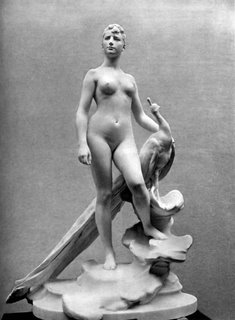 Woman with Peacock (marble)
Woman with Peacock (marble) Woman with Peacock (bronze)
Woman with Peacock (bronze)Taft may be too enthusiastic about the citizen-hero subject matter of the Rochejaquelin figure to notice that it's not much more than a cute illustration -- but I think he nails the problem with the peacock lady -- which just seems to be a full-nude portrait of a hooker -- while the Diana is just too voluptuous to seem chaste (especially compared with Houdon's version at the Frick) Maybe it's just that these pieces are site-specific to brothels rather than palaces. (and as Taft's biographer noted, he did not join his comrades in pursuing the pleasures of the flesh while studying in Paris). Perhaps we could call this the difference between the naked and the nude
I've shown both marble and broze versions of these pieces -- because it's fun to meditate on the substantial difference -- which led, I think, to the enthusiastic movement among sculptors for direct carving.
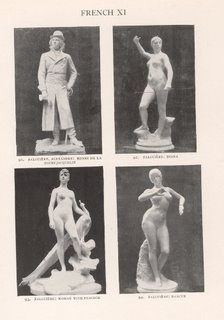 Figures 91-94
Figures 91-94For good or evil these men of enormous ability wield a corresponding influence; a nation’s art is largely shaped by them. Behold what such example did to Carles (Fig. 99), and Cordonnier (Fig. 100), and Picault!
Cordonnier was in my day counted one of the most promising of the young men. He had made a fine “ Joan of Arc” and other things of essential worth; now in his maturity he offers us such rubbish as his hysterical “Song.” It is laughable, but to me strangely pathetic.
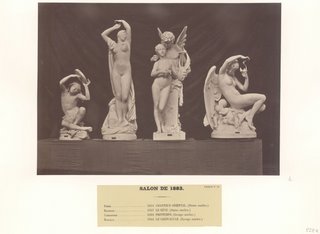 Cordonnier's "Spring" is third from left (1883)
Cordonnier's "Spring" is third from left (1883) Picault
PicaultThere's not a lot of internet examples available for Picault, Cordonnier, and Carles -- meaning that tourists don't photograph them and large museums don't display them -- and tje irony is that the ones that Taft shows excite me more than the ones found anywhere else. I really like Antonin Jean Carles' "Juno" and especially Alphonse Cordonnier's "The Song" -- which Taft has found "strangely pathetic". It reminds me of Donatello's singing choir boys -- except that this is a bare-breasted girl -- and she's not singing madrigals.
A striking illustration I recall. Away back in the early eighties, when Rodin was beginning to attract much attention, I met a young pupil of his, Mlle Camille Claudel. If ever youth bore the look of genius and inspiration it was to be read in the face of that slender, lovely girl. Her talent was evident in everything which
she produced. A fine head of her brother as “A Young Roman” revealed the great promise within her. When, some ten years later I was in Paris and saw her represented by that poor little curiosity, “The Gossips” (Fig 95), I was sadly chagrined. To think that daily intercourse with “the Master” should have brought such results
But the end was not yet. I had not seen “The Waltz” (Fig. 96)! This was followed by “The Ripe Age” (Fig. 97), a sculptural horror. Its title is a misnomer; it is far past ripeness. And finally we have that work of insanity, “Clotho” (Fig. 98), a combination of the tragedy of Rodin's dreadful "Heaulmiere" and the upright corpse of Ligier-Richier. Poor little Camille had run her course!
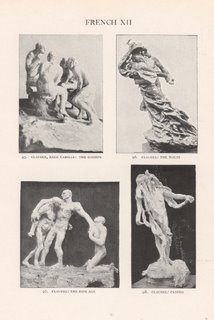 Figures 95-98
Figures 95-98I certainly agree about the sad story of Mlle. Claudel. She was more of a sculpture virtuoso than any of the men associated with Rodin -- but I guess it just shows that other abilities are needed to live as a sculptor. I get the feeling that she was very alone. Her straight-laced family wanted her to do something else and Rodin wanted to screw her -- but I don't think she had any real mentors who appreciated her gifts and wanted to help her.
I've seen her pieces at the Hotel Biron --- and they're as catastrophic as a bad acid trip.
Another pitiful exhtbition of decadence of ideals if not of craftsmanship is shown in the veritable rake's progress of Charpentier. His early success, "Illusion," was a figure of much beauty. His next offering, the "Shooting Star," was perhaps quite as well modeled, but suggests a clock top. This was followed by "Voluptuousness" (Fig. 102), skillfully done but hardly a great sculptural thought; and finally the world was gladdened by "The Bicycle" (Fig. 101), which all too loudly speaks for itself. Perhaps it is as well that we have no later works to present.
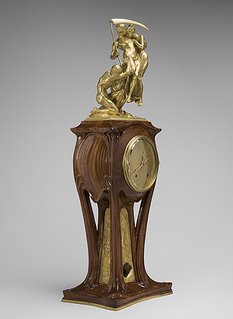 Charpentier 1899
Charpentier 1899 Charpentier, "Gomorrah"
Charpentier, "Gomorrah"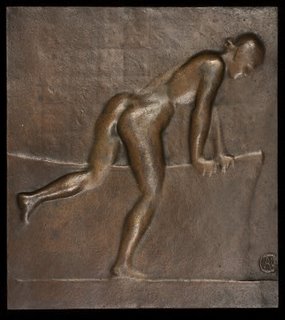 Charpentier, 1890
Charpentier, 1890I couldn't find the specific pieces that Taft has characterized as a "rake's progress" -- and I'm puzzled how what I found could be judged as "a pitiful exhibition of decadence of ideals". But Taft was right about his work often belonging "on top of a clock" -- as Charpentier, like Maillol, wanted to remove the line between art and decoration.
Of all the sculptors singled out for notice so far, Charpentier seems to be the one, today, who is getting the most exposure -- via his connection with home furnishings and Art Nouveau. The National Gallery is currently (Fall-2006) giving him a one-man show -- and claiming that it's the first he's had since 1910.
I like his relief of the bather -- but overall I'm not satisfied -- as he forsakes mass and pattern for linearity. Now that I recall it -- I've seen his medallions before -- and don't like them ---especially when placed beside the great medals of the Renaissance or ancient Rome.
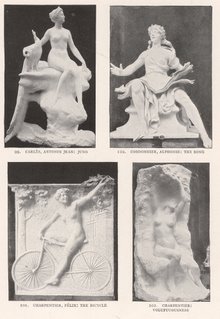 Figure 99-102
Figure 99-102These examples are significant because they are not the productions of ignorant beginners; most of them are the mature expressions of the leaders and men of standing in modern sculpture. Still others have emulated Rodin in eager portrayal of primitive passions, vulgarizing with insistent familiarity the most sacred things in life. Insensible to the charm and poetry of suggestion, such crude disciples of modernism picture all with a brutal frankness that repels. Sculpture has become taxidermy, and their stuffed men and women lack only 'color and real hair to vie with the wax tableaux of ethnological and surgical museums.
Regarding this summation -- I certainly share Taft's distaste for sculpture as taxidermy -- which is best examplified here in Chicago by the prolific Malvina Hoffman at the Field Museum -- but I don't mind "the insistent familiarity with the most sacred things in life".
Whatever is done with beauty and power feels sacred to me -- and whatever isn't, feels vulgar -- including that which has "the charm and poetry of suggestion"
For example, this detail from Lorado Taft's "Fountain of Time". This a wholesome, restrained, real-people couple -- not a fantasy of nymphs and satyrs -- and it feels true and melodic just like a good pop song -- but it still is only a pop song.
After such a review of the pre-war output of the Parisian studios one is able to understand the, warning of that great artist and seer, Albert Bartholome, whose noble monument, "Aux Morts" (Fig. 17), you have seen at Pere-Lachaise. “There will be no new Reraissance of French sculpture," says he, until the young; modelers turn once more to the limestone of which the cathedrals were built, and carve great, simple figures with it, as did the medieval masters." His keen artist mind realized that only through the exigencies of such material might be developed in France a grave and simple art, a new school of sculpture.
And this very thing is happening. The word of Bartholome is coming true. Just as his great vision of humanity's eternal sequence reaches beyond the grave, so we find even in the midst of France's agony a promise of a glorious resurrection. A group of her younger men began some years ago to " carve great, simple figures" in the Paris limestone. Their achievements have been notable; their promise for the future is still greater.
This is the movement toward direct carving, notably recorded by Kineston Parkes, and already mentioned here on this blog.
Before speaking of such conspicuous insurgents as Maillol, Bourdelle, and the more reasonable Bouchard, I wish to emphasize the fact that there has always existed a group of sane, sincere, and diligent craftsmen who, according to their varying tastes and intelligence have upheld the reputation of French sculpture.
*************** an ever-growing collection of relevant pieces as follows **************
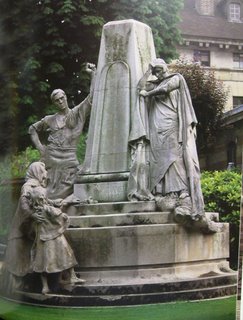 Jean Boucher "Ludovic Trarieux", 1907
Jean Boucher "Ludovic Trarieux", 1907


2 Comments:
I need a physical copy of this text. I want margins to scribble in.
Please send me your scribbles -- and I'll see if I can insert them into the text
Post a Comment
<< Home